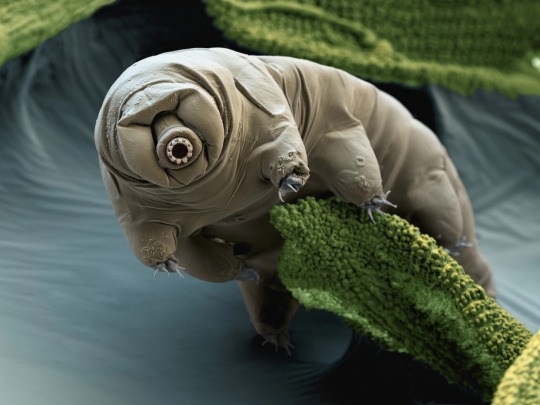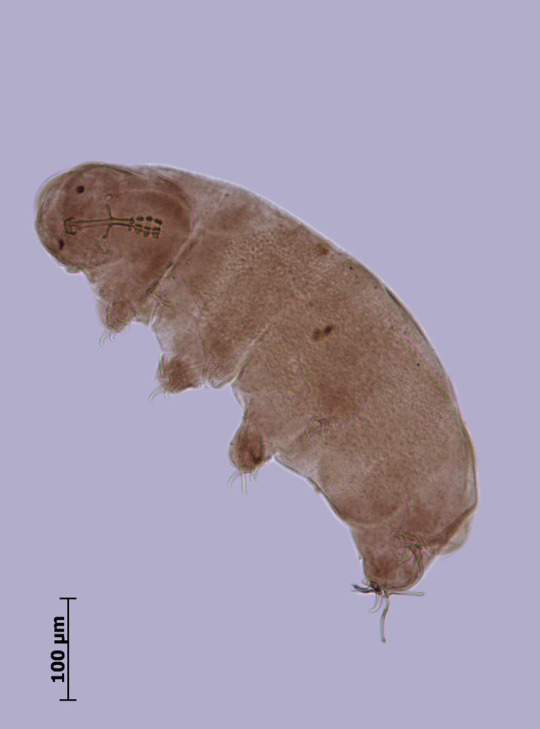#this is the LAST fully microscopic phylum
Explore tagged Tumblr posts
Text
Round 1 - Phylum Tardigrada




(Source - 1, 2, 3, 4)
The phylum Tardigrada comprises eight-legged, segmented, microscopic animals commonly known as Water Bears or Moss Piglets.
Tardigrades have been found in many different ecosystems, from mountaintops to the deep sea to the Antarctic. They are known for their extreme resilience, being able to survive extreme temperatures and pressures, air deprivation, radiation, dehydration, starvation, and even exposure to outer space. However, they prefer to just live in mosses, lichens, and sediments, munching away on plant cells, algae, bacteria, or small invertebrates (including smaller tardigrade species; that’s not cannibalism btw, plenty of chordates eat other chordate species!) They are not considered extremophiles though, as they are not adapted to exploit extreme environments, only to endure them. They do this by going dormant in harsh environments, for up to 30 years, only to rehydrate and continue living when conditions are safer!
Tardigrades are usually about 0.5 mm long when fully grown, with the largest species reaching up to 1.5 mm. They are short and plump, with barrel-shaped bodies and eight legs, each ending in claws or suction disks. Their backwards-facing hind legs allow them to move in reverse when needed. Like arthropods, they have a cuticle exoskeleton which needs to be molted as the animal grows. They feed using a pair of stylets within their tubular mouth, which they use to pierce their food and suck out the contents. These stylets are lost when the tardigrade molts, so they must secrete a new pair each molt. Some species only defecate when they molt, leaving behind both feces and a shed exoskeleton. They have a large brain for their size, and sense the world via sensory bristles, and some species also have pigment-cup eyes. There are both males and females, with females being larger and more common. Males will gather around a female to court her. Most species have external fertilization, with eggs being laid within a shed cuticle by the female and then fertilized by the male. They can live from several months up to two years, depending on species.
There are two main groups of tardigrades, the Eutardigrades which are the more chubby, suction-cup-fingered ones and the Heterotardigrades, which are the armoured, clawed ones. The oldest known modern tardigrades have been found in Cretaceous amber, but their phylum likely emerged in the Cambrian.

Propaganda under the cut:
I mean… they’re freakin tardigrades. They’re cute. They look like mini Catbusses. This is probably the only microscopic animal for which this many plush toys exist.
“Tardigrada” means “slow steppers”
One species, Echiniscoides wyethi, lives on barnacles.
Tardigrades are relatively common and easy to see with a microscope, making them good subjects for budding microbiologists to study. They can also be kept as pets on a piece of moss, regularly checked via microscope.
They don’t actually like all the extreme environment stuff. Stop putting them in space. Let them chill.
#animal polls#round 1#this is the LAST fully microscopic phylum#we are getting to the Big Boys now#tardigrada
116 notes
·
View notes
Link
It is still several months away from the wild mushroom season, the la chasse aux champignons, which is a national pastime here every autumn in France. I am intently looking forward to it and have been sharpening my mushroom knife in anticipation.
As mushrooms are one of my favourite foods, I thought it might be interesting to explain a few things about them. As few people will ever get to pick clitocybe nuda or slice the stalks of boletus pinicola, I will discuss only the commercially farmed varieties today. If you are interested, some details about last year’s wild mushroom season is described in my previous article, Autumn tales from rural France.
Various species
Until a few years ago, most of what we call “mushrooms” in supermarkets are from a single species called Agaricus bisporus. There are two variants of this species: a white variety and a nutty brown variety.
Despite the difference in price, both white and brown varieties taste exactly the same so there is no requirement to pay more for the brown variety. In its immature state, the white variety are sold as button mushrooms, crimini mushrooms and champignon paris. When immature, the brown variety are marketed as Swiss browns, Roman browns, Italian browns, cremini mushrooms, or chestnut mushrooms. Fully-matured Agaricus bisporus are generically known as Portobello mushrooms and can be white or brown.
But modern supermarkets now stock many more fresh varieties such as shiitake (Lentinula edodes), oyster/abalone (members of the Pleurotus family), enoki (Flammulina velutipes), chanterelles (various members of the Cantharellus, Craterellus, Gomphus, and Polyozellus genera), etc.
Modern supermarkets now stock all kinds of mushrooms, like shiitake (pictured here). Photo: Filepic
In other parts of the world, you will likely find even more regional mushrooms in the markets. For example, in Bavaria, Germany, I have come across local waldpilze varieties such as Krause Klucke, Steinpilz, Semmelstoppel, Rotkappe, Nelkenschwindling, Schafsporling, Maronenröhrling, etc. I do not actually know what species they are but they are often found in the local dishes, and they are delicious. Unfortunately, they are not commonly available outside Germany so if I need them, the only option is a flight back to Berlin where they are sometimes available.
One curious thing about mushrooms is that they are not plants and of course they are not animals either. Although we all know them as fungi, edible mushrooms are only found in the Basidiomycota and Ascomycota divisions of the sub-kingdom Dikarya with the Fungi kingdom.
As an aside, the Ascomycota division is the largest phylum (or grouping) of the Fungi kingdom with over 64,000 different species. Ascomycetes are defined by the “ascus” (Greek for “sac”) which is a microscopic sexual structure where spores are formed.
Common examples of ascomycetes are the yeasts used for brewing and baking, and more importantly the penicillium species which are used to produce (usually) blue cheeses and various antibiotics. The Aspergillus species used in the fermentation of soy sauce is also an ascomycete. Unfortunately, most ascomycetes are potent pathogens to both mammals and plants, and can be deadly to humans and ruinous to crops.
In the past, mushrooms were usually identified or classified by “spore prints”, the powdery image left by spores falling from the gills of mushrooms onto pieces of paper. These days, chemical tests and DNA analysis are available to detect certain types of mushrooms, though most people still rely on pictures in guide books.
If you’re looking to forage for mushrooms, it is best to go with someone with experience as mushroom poisoning can be serious. Photo: Aleksey Gnilenkov/Flickr
While guide books can definitely be useful, it is much better to have someone knowledgeable guide you through a few mushroom hunts before going on your own as mycetism (mushroom poisoning) can be very serious.
Although most supermarket mushrooms can probably be eaten raw, people generally prefer to cook them as the fungi can be used to add flavours to dishes or even eaten as a dish by itself. This is one area where mushrooms should be treated differently from other foods.
Overcooking
Many people would know that overcooked vegetables tend to turn into mushy goo, while overcooked meats taste like dry, flavourless cardboard. However, mushrooms tend to resist overcooking much better than other foods. And this also explains why mushrooms taste “meatier” than vegetables.
The reason why mushrooms resist overcooking is because cells in mushrooms are formed from a compound called chitin, the same compound found in the exoskeletons of arthropods such as crustaceans, insects, scales of fish, etc. Chitin is formed from long chains of a monosaccharide sugar called N-acetylglucosamine and is remarkably heat stable, holds it shape well, and will not coil into tough bundles under heat like meat proteins nor disintegrate like plant cells, which tend to be held together by a compound called pectin, which breaks down easily under heat.
In fact, mushrooms are often the only whole non-meat ingredient still recognisable in a long-cooked stew.
Too much oil
Anyone who loves fried mushrooms probably made the same mistake as when I started frying them. I found that mushrooms can absorb prodigious amounts of oil – even 200 grams of mushrooms could use up a quarter of a bottle of olive oil. They taste great but even I was uneasy about the amount of oil I was ingesting. So where did all this oil go in the mushrooms?
It turns out cooking oils end up getting trapped in the hyphae of the mushrooms. The hyphae is a collection of cells surrounded by tubular cell walls made from chitin. These structures hold a lot of air, which also explains why mushrooms tend to feel light in the hand. When cooking, the chitin structures remain stable while the pan heat drives the air out from the hyphae – the air is then replaced by sucking in the cooking oil.
Mushrooms do not require much oil for cooking. Photo: Sandra Holt/Flickr
A much more healthy way to cook mushrooms is therefore to ensure the chitin tubes in the hyphae are filled first before using any oil at all. Oil would only be needed to brown the mushrooms before eating. Since we now know that the chitin tubes can act like microscopic straws, this can also be a good time to add extra flavours to mushrooms.
So when frying mushroom, add a good splash of either plain water or some form of stock to the pan at the beginning, then cook until the mushrooms have softened and absorbed the original liquid. If they look under-cooked, add a bit more liquid if necessary. Then when the mushrooms have absorbed all the liquid and are starting to look dry, add a little oil to the pan and cook till brown. As a final touch, add some butter near the end of cooking to impart extra flavour and sprinkle on salt and pepper before serving.
A future food
Interestingly, there appears to be a lot of research into using mushrooms or fungi for creating viable substitutes for meat. The hollow structure of fungal hyphae can act as an absorbent foundation for flavour compounds delivered as liquids. Then the ability of chitin to maintain its structure and textures under heat means there is potentially a lot of flexibility in how flavours and textures can be created using mushrooms or fungi material as the base ingredient used in combination with other vegetarian materials.
from Food – Star2.com http://bit.ly/2W53szb
0 notes